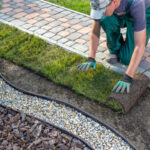Creating the perfect outdoor space is more than just planting a few flowers or laying down some patio stones—it’s about designing a functional, beautiful, and cohesive environment that enhances your lifestyle and boosts your property’s value. If you’ve been thinking about transforming your yard, you’ve probably come across the MGM Landscape Inc terms hardscaping and softscaping. While they might sound technical, they’re the two essential components of landscape design. Understanding the difference—and how to strike the right balance—can make all the difference in crafting an outdoor space you’ll love for years to come.
What Is Hardscaping?
Hardscaping refers to the non-living elements of your landscape design. Think of anything made from stone, wood, brick, metal, or concrete—these are all considered hardscape features. Popular examples include:
- Patios and decks
- Retaining walls
- Walkways and pavers
- Outdoor kitchens
- Fire pits
- Fences
- Water features like fountains or ponds
These elements serve as the structural bones of your yard. They create defined areas for entertaining, relaxing, and moving through your outdoor space. Done right, hardscaping adds elegance, order, and function.
What Is Softscaping?
Softscaping, on the other hand, includes all the living, growing elements in your yard. This is the lush, colorful, and organic side of landscape design. Softscape features typically include:
- Grass and lawns
- Flower beds
- Shrubs and trees
- Ground covers
- Garden beds
- Vines and hanging plants
Softscaping brings life, color, and texture to your yard. It softens the edges of hard surfaces and can be used to direct views, add privacy, or simply enhance the natural beauty of your property.
Why Balance Matters
When designing a landscape, it’s not about choosing hardscaping or softscaping—it’s about achieving the right mix of both. A yard made entirely of stone and concrete can feel cold and uninviting, while one filled only with plants may lack structure and usability. The key is to blend these elements in a way that supports your lifestyle and complements your home’s architecture.
For instance, a stone patio surrounded by colorful flower beds can create a seamless indoor-outdoor living experience. A retaining wall can hold back a hillside while doubling as a garden bed. Even a winding stone path can feel warmer and more inviting when lined with vibrant greenery.
Designing for Function and Aesthetics
Hardscaping and softscaping each play critical roles in both the function and aesthetic of your landscape. Hardscape elements provide surfaces to walk, sit, and entertain on, while softscape elements provide shade, fragrance, privacy, and color.
You might love the idea of a spacious patio, but without surrounding plants or shade trees, it could feel exposed and too hot in the summer. Likewise, a garden without any pathways may look beautiful but be difficult to navigate or maintain.
A skilled landscape designer knows how to use both to their fullest potential—creating a space that’s as practical as it is beautiful.
Maintenance Considerations
It’s also important to think about maintenance when deciding how much of your yard should be hardscape versus softscape. Hardscape features typically require less maintenance once installed. You may need to pressure wash a patio or re-level pavers over time, but they don’t need to be watered, pruned, or fertilized.
Softscape elements, while beautiful, do require regular attention. Lawns need mowing, flowers need watering, and trees need trimming. If you prefer low-maintenance landscaping, you may lean more toward hardscaping with drought-tolerant or native plants integrated into the softscape.
Environmental Impact
Another factor to consider is the environmental impact of your choices. Softscaping helps manage rainwater, supports pollinators, and can cool your yard through shade and evapotranspiration. Hard surfaces, on the other hand, can increase runoff and heat retention if not thoughtfully designed.
That’s why blending the two is not just about aesthetics—it’s also about creating a sustainable, environmentally-friendly space. For example, permeable pavers allow water to drain through while still giving you a solid walking surface. Using native plants in your softscaping can reduce your water and chemical use.
Customization Based on Lifestyle
Your outdoor space should reflect your lifestyle. Do you love hosting summer BBQs? A well-designed patio, outdoor kitchen, and fire pit could be the perfect hardscape setup. Prefer a peaceful retreat surrounded by nature? Focus more on lush plantings, shaded seating areas, and soft, organic lines in your design.
Families with children or pets might prioritize open lawns or durable paths. Gardeners might want raised beds and shaded areas for different plant types. The right balance of hardscape and softscape depends on how you use your space and what brings you joy.
Getting Professional Help
While it’s tempting to DIY your yard, creating a cohesive and balanced design is more complex than it seems. A professional landscaping team can assess your property’s unique layout, soil conditions, drainage, and sunlight to develop a custom plan that works for you.
They can guide you through selecting the best materials, plants, and layout to match your lifestyle and climate. More importantly, they’ll ensure the balance between hardscaping and softscaping is just right, giving you a space that’s both functional and inviting.
Elevate Your Landscape with the Right Mix
Your outdoor space is an extension of your home—and finding the right harmony between hardscaping and softscaping is the secret to making it truly exceptional. With thoughtful design, you can enjoy a space that’s low-maintenance yet stunning, durable yet soft, practical yet peaceful.
Whether you’re starting fresh with a new yard or upgrading your existing space, don’t settle for one or the other. Invest in both hardscape structure and softscape beauty to create a balanced landscape that serves your needs and impresses your guests.

